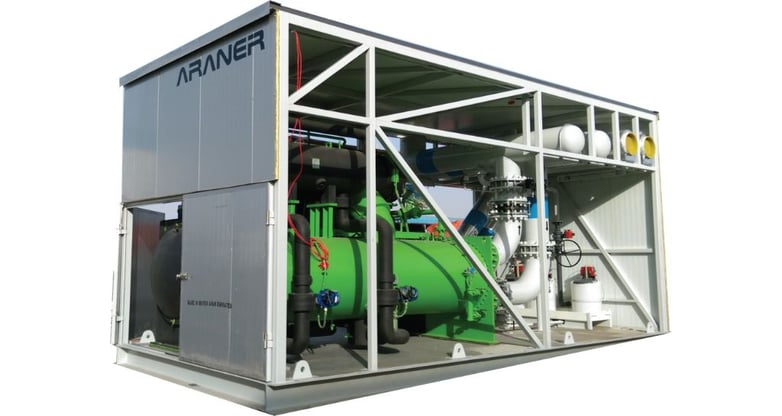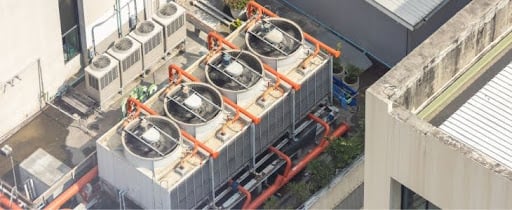Modular cooling stands at the heart of many modern cooling solutions addressing very specific needs for industrial developments and beyond.
Known for their rapid deployment, modular cooling systems offer a quick and efficient solution when there's an urgent need for cooling, such as during emergencies or temporary events (for instance, they have been central for temporary medical facilities and vaccination centers).Highly flexible and scalable, modular cooling can also represent a good option for projects where cooling requirements may vary or expand over time. As such, modular cooling systems can be designed to meet specific project requirements, while allowing the necessary flexibility to changing operational conditions. Put briefly, in modular cooling, components can be added, removed, or reconfigured as needed, all in the name of optimizing performance and efficiency.
This is particularly important at a time when sustainability and energy efficiency are paramount. As the International Energy Agency claims 20% of electricity worldwide is employed for cooling purposes, a transformation towards sustainability in the field could have major consequences.
As such, the integration of modular models into district cooling projects allows for a centralized approach to cooling that is more energy efficient and sustainable. This, in turn, can be further optimized given the right choice of cooling tower.
However, modular cooling should not become a ‘one-size-fits-all’ solution. What exactly are modular cooling systems and when are they the right choice? Let’s take a look.
What is modular cooling?
Modular cooling is an approach to cooling that is based on creating a cooling system based on prefabricated components (modules).
In modular cooling projects, the system’s components are typically built off-site at dedicated manufacturing facilities, and then assembled on-site. This allows for a faster installation.
At the same time,elements such as modular cooling towers, chillers, pumps, and control units can be added or removed as needed, allowing for easy scalability: in order to increase or decrease cooling capacities, it’s possible to simply incorporate or remove additional modules.
What are the benefits of modular cooling?
Substantial adaptability
Projects that are built with expected variations in cooling requirements and capacities can benefit from modular cooling models. As such, modular cooling systems present major adaptability options, including:
- Flexibility to different available spaces. When space constraints are involved, modular cooling can be the answer, as it’s designed with careful consideration of space distribution to ensure optimal use. While a steel frame serves as the structural backbone of the modular cooling system, potential scalability can be achieved with minimal disruption to ongoing operations.
- Adaptability to fit specific cooling needs. Modules can be added or removed to accommodate changes in cooling demand, increase capacity or optimize efficiency.
A ‘plug & play’ approach to cooling
Modular cooling plants undergo thorough testing before being transported to the plant, ensuring they meet design conditions and cooling capacity standards. This, in turn, translates into a faster installation, including assembly, connection and commissioning; and reduced mobilization of technical, supervisory and labor personnel. The result is savings in time and resources, leading to quicker project completions.
Cost savings
The flexibility and scalability of modular cooling allows operators to ensure their project remains efficient over time and adapts to actual cooling demand, thus leading to cost savings.
This is combined with a streamlined manufacturing process and reduced on-site construction time, resulting in an added reduction in costs.
Space considerations
While modular cooling is not as effective as tailor-made cooling systems in this regard, modular approaches can be designed to maximize space or ensure a compact footprint.
At the same time, modular cooling solutions allow for an easy relocation of equipment, in case it’s needed.

When is modular cooling the right choice?
Any initial phase of designing and implementing a cooling project may start from considering the following questions:
- What is the area that will be served?
- What are the characteristics of the cooling demand to be served? What are the specific cooling requirements of the project in terms of capacity, temperature control, and reliability?
- What climatology conditions and challenges should be considered?
- Are there any spatial constraints that need to be taken into account?
- What is the project timeline, and are there any urgent deadlines to meet?
- What are the cost-saving measures or efficiency goals that need to be considered?
- How flexible does the cooling system need to be to adapt to future changes or expansions?
- What are the environmental considerations that the project should fulfill, including desired energy efficiency, sustainability, and goals in emissions reduction?
- Are there any specific industry standards or technical specifications and performance criteria that the project needs to meet?
In light of these questions, and as seen above, modular cooling systems can offer several advantages for projects that:
- Foresee changing or fluctuating cooling demands
- Present an urgency in project timelines
However, modular options aren’t always the best fit, and certain projects can benefit from adopting a customized approach instead of a modular model.
In fact, modular cooling systems that are not well adapted to the specific project may present issues in terms of effectively meeting cooling demand. As such, concerns have been raised about potential underutilized equipment or lower operating efficiency due to including separate controls for each skid.
In several cases, well-designed and managed tailored cooling projects can help operators optimize equipment for maximum efficiency. In fact, conventional cooling plants can be designed and built in stages to match anticipated cooling demands, thus also adding a certain degree of scalability that can benefit certain projects.
All in all, modular cooling and tailor-made solutions represent two distinct approaches to addressing cooling needs, each with its own set of advantages and considerations to be made. As such, while tailor-made projects may require more time and resources upfront, they offer unparalleled precision and optimization tailored to the specific needs of each project.

This is precisely where consulting thermal and cooling experts comes in. A team of experts can help stakeholders navigate the decision-making process by providing insights into the pros and cons of each approach, all while analyzing the specific project requirements to be met.
At ARANER, we offer modular cooling products and services, all while recognizing the value of customized facilities to help companies achieve their specific cooling goals.
As such, we put our thermal engineering expertise to work to devise state-of-the-art district cooling solutions. Through cutting-edge simulations, tools, equipment and project management practices, we’re able to deliver high-quality projects that adjust to the specifics of each client’s needs.
Our customized solutions include all details in each project, from the choice of the right cooling tower model to devising equipment that will respond effectively to the expected cooling demand.
At the same time, sustainability and cost-effectiveness lie at the heart of our operations. As such, we’re committed to sustainable cooling models, such as district cooling, where energy efficiency meets both environmental and economic goals.
Are you considering a modular cooling approach but want to ensure this is the right choice for your project?
At ARANER, we can help you design, build and implement the cooling system you need.
Download our district energy ebook to learn more about the advantages of this approach to cooling and get in touch with us to speak to our team about how we can help you.










